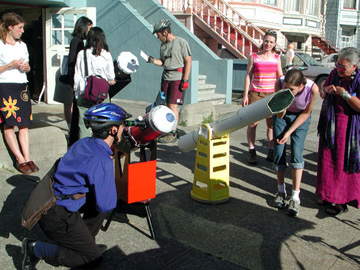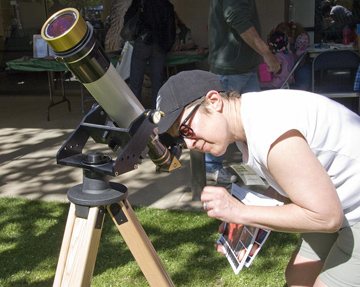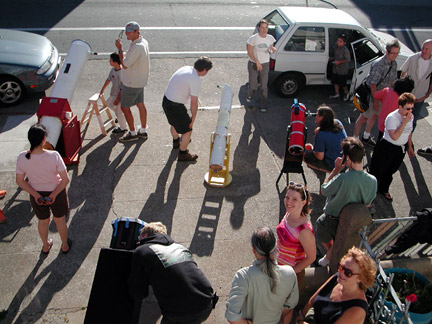Solar sidewalk astronomy - sharing the sun with your community (February 2009)
I'm Jane Houston Jones. During the work week, I'm a Senior Outreach Specialist at Jet Propulsion Laboratory in California where I coordinate informal education for the Cassini Mission to Saturn. It's an exciting job, writing about Saturn, answering questions from the public, and working with museums and planetariums. I'm also the Twitter "voice" of the Cassini spacecraft, "tweeting" 140-character micro blogs "from" the spacecraft to over 7,000 enthusiastic Twitter followers. And I coordinate a 400-member international outreach network called the Saturn Observation Campaign.
Once a month I develop a podcast called "What's Up" which features a different monthly stargazing sight like the sun or a planet, tied to a NASA mission. In May 2009, I'll be talking about the sun!
Outreach may be my day job, but since I am a sidewalk astronomer too, astronomical outreach is also my hobby! I belong to the Old Town Sidewalk Astronomers club, an informal group of about 10 amateur astronomers. We do about 5-10 events per month. In 2008 we conducted 50 public service events for nearly 5,000 people. In 2007 it was double that. We like to show the sun, moon and planets to the community while conducting sidewalk astronomy events.

Sidewalk astronomy is an informal way of bringing the universe to your community. On a sunny day I might take one of my telescopes down to a busy sidewalk in my town, park the car, unload and aim a solar safe telescope at the sun. I make sure that I have a ladder or stepstool so the younger visitors can reach the eyepiece. I also have a sign on the telescope explaining to people never to look "directly" at the sun, or without a trained astronomer using a solar safe telescope. Before heading out, I take a look at several solar websites (including SOHO) and print out that day's solar activity images. This way I can point out any interesting features to my guests, or if I have a helper, he or she can show the people in line what to expect at the telescope eyepiece.
I have telescopes equipped with two kinds of filters and I bring both of them out on the sidewalk. One has a white light filter that shows how the sun looks to the unaided eye. The viewer sees the photosphere, or the apparent surface of the sun, which has a temperature of 6,000 Celsius. You can say this is the sun you can "see" or what you see through a projection onto a piece of paper.
The other is an h-Alpha filter, which shows just one wavelength of light -the red light of hydrogen (wavelength of 656.3 nanometers). With this we see the next highest layer of the sun - the chromosphere (temperature between 6,000 and 20,000 C.) We need a filter to see this layer because the brighter photosphere layer below washes out the fainter chromosphere, just like a bright streetlight would wash out the light of a flashlight. What you see through an h-Alpha filter are ribbony dark colored filaments against the disk and prominences on the edge, many times longer than the diameter of the Earth!

Often, my Old Town Sidewalk Astronomers members are asked by a scout troop or an elementary school to bring a solar telescope to camp or school or a local museum and we are more than happy to oblige. We ask the coordinator to check a few things about the location and time of the proposed event to see if there are trees or buildings in the way of the sun at the time they want to hold their event. I also ask the requestor to choose a rain delay date in case we are clouded or rained out. And I always have a reserve "indoor" hands-on-activity in case of rain.

If you don't have a solar telescope, you might ask your local astronomy club to help out. If you have a telescope already, you can make solar filters or purchase them. I've made solar filters for almost all of my telescopes using the plans below and have purchased filters for the other telescopes. Both white light and h-alpha filters are available anywhere telescopes are sold. Solar projection using a pinhole projection is another safe way to view the sun. No matter what method or equipment you use, your viewers, just like mine, will be thrilled to have looked at their own star!
Useful resources: Make your own solar filter and Make a pinhole projector.
TELL US ABOUT YOUR ACTIVITIES: If you use our SOHO images or movies, provide outreach and programs in the area of solar study, and would like to be considered for our Outreach Spotlight section, write to steele.hill[at]gsfc.nasa.gov with a brief overview of your efforts.If we think you'd make a good candidate, we will contact you.


